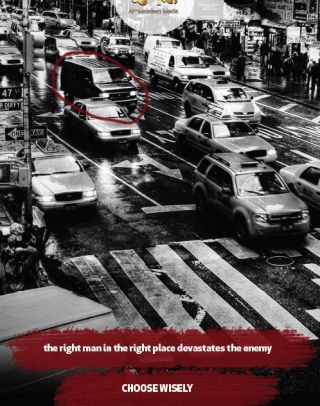Intelligence
Inspire Magazine: Continued Notoriety with Issue No. 12
Car bombs, arson, and the effort to inspire terrorism in the US
Posted April 7, 2014

Al-Qaeda in the Arabian Peninsula (AQAP) recently released the 12th issue of Inspire, and it already succeeded in getting the attention of US intelligence. It also put the NYPD on high alert, the New York Police Commissioner telling the New York Daily News he sees the magazine, and the current issue, a significant threat. For a publication once considered by many - both analysts and participants on jihadist forums - as a hoax, Inspire is now taken quite seriously. It commands the kind of attention most extremist publications could only dream of. Perhaps its continued influence is even more surprising considering American drone strikes killed the founding editors, Anwar al-Awlaki and Samir Khan, in 2011.
How has Inspire done it? Simply put, it appears to have inspired terrorists by developing (and sticking to) a model for its content to influence the behavior of readers. For its target audience, Inspire provides the information, motivation, and skills to move some people toward taking violent action.
Whether or not it is intentional, Inspire’s model links to successfully tested models of behavioral change. Our research team has recently published a paper in the journal Terrorism and Political Violence that provides a detailed account of this analysis, and Tony Lemieux has previously blogged about it here. We argue that for jihadi publications, Inspire appears to have some unique properties that may help explain its apparent potential to influence its readers. Of course, it is difficult to definitively prove a publication’s real world impact, but the evidence is getting hard to dismiss or deny. As New York Police Commissioner Bill Bratton told the New York Daily News: “We are certainly concerned by Inspire…Inspire, if we understand it correctly, was the inspiration, if you will, for the Boston Marathon bombers.”
Indeed, Inspire has been implicated in a number of terrorism cases, but the Boston Marathon bombing and the subsequent manhunt, may have raised the magazine’s profile. It is now widely known that the Boston Marathon bombers, brothers Tamerlan and Dzhokhar Tsarnaev, built pressure cooker bombs according to the step-by-step instructions in Inspire’s first issue – from the now infamous article “How to Build a Bomb in the Kitchen of your Mom.” So far, there is no evidence yet that the Tsarnaev brothers were influenced by anything more than the “skills” training portion of Inspire. However, consider Dzhokhar Tsarnaev’s tweet about one week before the attack: “If you have the knowledge and inspiration all that’s left is to take action.” Coincidence, perhaps, but this tweet describes the essence of Inspire’s message.

Inspire’s 12th issue stays true to their model, providing relevant and recent information, pieces intended to motivate, and a following skills-building section dubbed ‘open source jihad’. For anyone interested in some insight into AQAP and Inspire, this issue includes its justification for killing civilians, grievances with the United States, views of drone warfare, and the ultimate goal of Inspire magazine – to unequivocally force the reader into a choice between taking action, or being a disgrace and a coward. As in previous issues, Inspire presents information that attempts to establish “reasonable” positions. It cites respected voices and organizations from the West to make its point. For instance, instead of simply claiming AQAP is America’s greatest threat, Inspire quotes someone at a US intelligence meeting: “AQAP poses the greatest threat to the US homeland because it has directly targeted the US homeland as well as US interests abroad on multiple occasions.” In criticizing drone warfare as immoral and counterproductive, Inspire provides a page of supporting quotes from General Stanley McChrystal, writers from the Economist and the Guardian, Human Rights Watch, and others. It is a rather ingenious ploy, as it lends credibility to the perspective of a terrorist group.
To motivate readers, this issue uses the powerful barbs of guilt and the threat of Hell to discourage inaction. As such, Inspire tells its readers about injustices, then argues that to know and not act is cowardice. In other words, it tries to create a feeling of moral obligation and personal responsibility in the reader. In a posthumous piece by Samir Khan on his personal journey from activism to joining Al-Qaeda, he confides to the reader: “When people brought up subjects I used to explode upon, I would find myself exceptionally quiet. It was because I felt a sense of utter hypocrisy for just being a talker…If one knows that he has the ability to fight…then nothing should stop him.” Throughout this issue, as in previous ones, readers are told that sympathy is pointless. The only way out of shame is to act.

This, of course, is where the skills-training section of the magazine, called “Open Source Jihad,” comes in. It was in this section where the Tsarnaev brothers, and a number of other terrorist suspects, have learned the skills to take the step into terrorism. The author, the AQ Chef, gives a sales pitch of sorts in this issue: “Inspire Magazine’s goal is to empower Muslim Youth. And what is empowerment without being strong, powerful and intelligent? In this section, we give you strength, power, and intelligence. Believe me, using car bombs gives you all that.”
Of course, one should not be alarmist about the threat of a magazine. The link between media and action is inconclusive, and the actual influence of this publication above and beyond other sources has yet to be empirically established and validated. Still, if any extremist propaganda warrants close attention, it is Inspire. Its model appears to be effective in generating significant interest, and this issue reveals a magazine written in a tone that is as confident as ever. In the coming weeks, we can expect a competing English-language publication to be produced by Al Qaeda central, called Resurgence. It will be interesting to see how that publication compares to Inspire.

Authorship note: This piece was lead-authored by Jason Levitt, Presidential Fellow in the Transcultural Conflict and Violence Program at Georgia State University, in collaboration with Anthony Lemieux.


